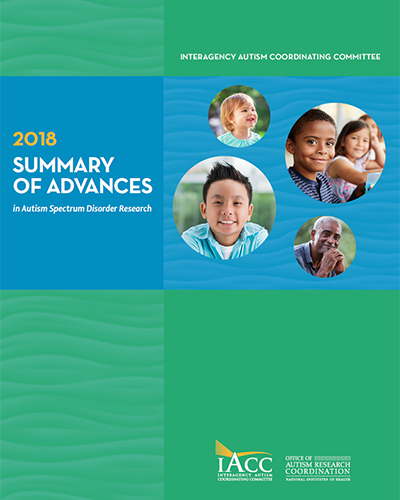Summary of Advances
In Autism Spectrum Disorder Research
2018
Prevalence of Autism Spectrum Disorder Among Children Aged 8 Years - Autism and Developmental Disabilities Monitoring Network, 11 Sites, United States, 2014.
Baio J, Wiggins L, Christensen DL, Maenner MJ, Daniels J, Warren Z, Kurzius-Spencer M, Zahorodny W, Robinson Rosenberg C, White T, Durkin MS, Imm P, Nikolaou L, Yeargin-Allsopp M, Lee LC, Harrington R, Lopez M, Fitzgerald RT, Hewitt A, Pettygrove S, Constantino JN, Vehorn A, Shenouda J, Hall-Lande J, Van Naarden Braun K, Dowling NF. MMWR Surveill Summ. 2018 Apr 27;67(6):1-23. [PMID: 29701730]
One of the goals of research on ASD is to understand the prevalence, or number of people with ASD in a given population and the characteristics of those individuals. The Autism and Developmental Disabilities Monitoring (ADDM) Network is a program supported by the Centers for Disease Control and Prevention that tracks over time the number of eight-year-old children with ASD in participating sites; in this report there were 11 participating sites in the following states: Arizona, Arkansas, Colorado, Georgia, Maryland, Minnesota, Missouri, New Jersey, North Carolina, Tennessee, and Wisconsin. In this report, the authors estimated the prevalence of ASD in the ADDM Network among 8-year-old children in 2014. In particular, this report assessed prevalence rates of ASD based on diagnostic criteria in the Diagnostic and Statistical Manual of Mental Disorders, Fourth Edition, Text Revision (DSM-IV-TR), compared to the criteria in the updated Diagnostic and Statistical Manual of Mental Disorders, Fifth Edition (DSM-5).
The researchers estimated prevalence by collecting data from children’s health records and, in most cases, education records. Clinicians then reviewed the data and assessed ASD status based on criteria established in the DSM-IV-TR and the DSM-5. They found that the overall prevalence of ASD in 8-year-old children was 1 in 59, and it was four times higher in boys than girls. Prevalence estimates also varied by race/ethnicity, with a 7% higher prevalence in white children than black children, and a 22% higher prevalence in white children than Hispanic children. The researchers noted that the increase in diagnostic rates among black children compared to reports from previous surveillance years likely does not represent an increase in prevalence, but rather an improvement in ascertainment. Also, although the majority of parents reported having concerns about their child’s development by 36 months of age, the median age of formal diagnosis was 52 months of age.
Among the sites with data on intellectual disability, 31% of the children with ASD had IQ scores of 70 or lower (intellectual disability), 25% had IQ scores of 71-85 (borderline intellectual disability), and 44% had IQ scores higher than 85. Girls were more likely than boys to have IQ scores of 70 or less. The proportion of children with ASD and intellectual disability was similar in 2010, 2012, and 2014, but markedly lower than those reported in previous surveillance years, indicating that in recent years, more children with ASD and no intellectual disability are being identified.
In general, the researchers found that DSM-IV-TR and DSM-5 diagnosis criteria resulted in very similar measures of ASD prevalence, both overall and when specifying for demographic features, such as gender, race, ethnicity, and level of intellectual ability. When reevaluating cases based on DSM-5 criteria, the researchers found that 86% of children met criteria for both, 9% met criteria for the DSM-IV-TR only, and 5% met criteria for the DSM-5 only. The overall prevalence estimates were 4% higher using the DSM-IV-TR than the DSM-5 criteria.
These results indicate that the estimated prevalence of ASD was higher in 2014 than in previous surveillance years. The prevalence estimates continue to vary by racial and geographic groups, but some of these disparities have decreased relative to previous years. The increasing prevalence of ASD is an important public health concern, requiring significant services and resources to address the needs of this population and continued research to better understand the risk factors associated with ASD.




